Supply Chain Management Report: Royal Mail Group Analysis
VerifiedAdded on 2022/12/05
|9
|3439
|290
Report
AI Summary
This report provides a comprehensive analysis of the supply chain management of Royal Mail Group plc, a global courier and postal service company. It begins with an introduction to supply chain management, emphasizing its role in balancing supply and demand and enhancing competitiveness. The report then delves into the core functions of supply chain management, including coordination, demand-oriented creation, and customer relationship management. It explores the importance of relationships within the supply chain, highlighting the benefits of improved efficiency, waste reduction, and cost savings. The report also examines the impact of information systems on supply chain management, procurement and outsourcing strategies, and the significance of sustainability. It further discusses ways to improve supply chain management, such as leveraging technology, promoting clear communication, reviewing performance, and ensuring timely payments. Additionally, it covers strategies for mitigating supply chain risks and reducing costs, including implementing contingency plans, assessing suppliers, and improving cyber security. The report concludes with a discussion on how a supply chain management can be sustainable.
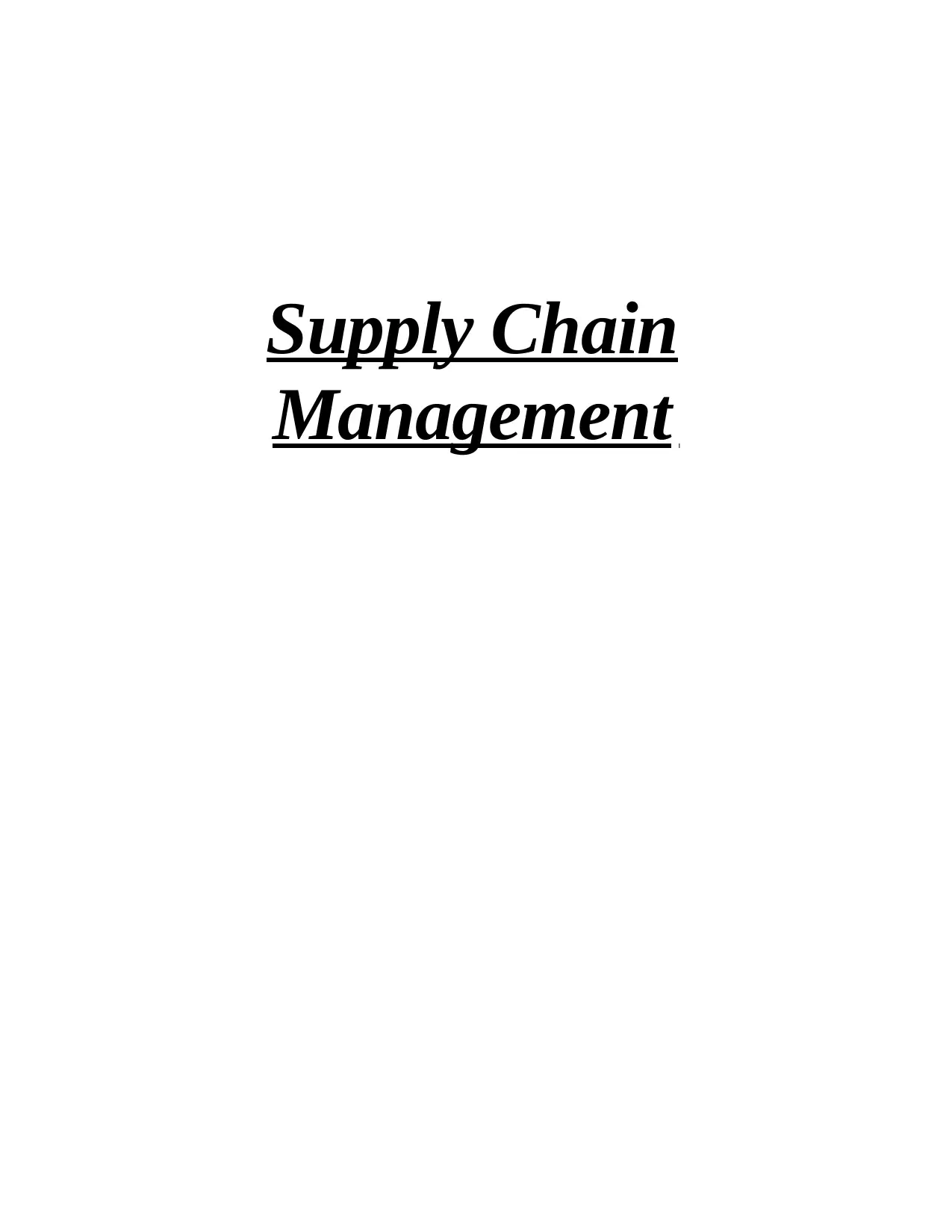
Supply Chain
Management
Management
Paraphrase This Document
Need a fresh take? Get an instant paraphrase of this document with our AI Paraphraser
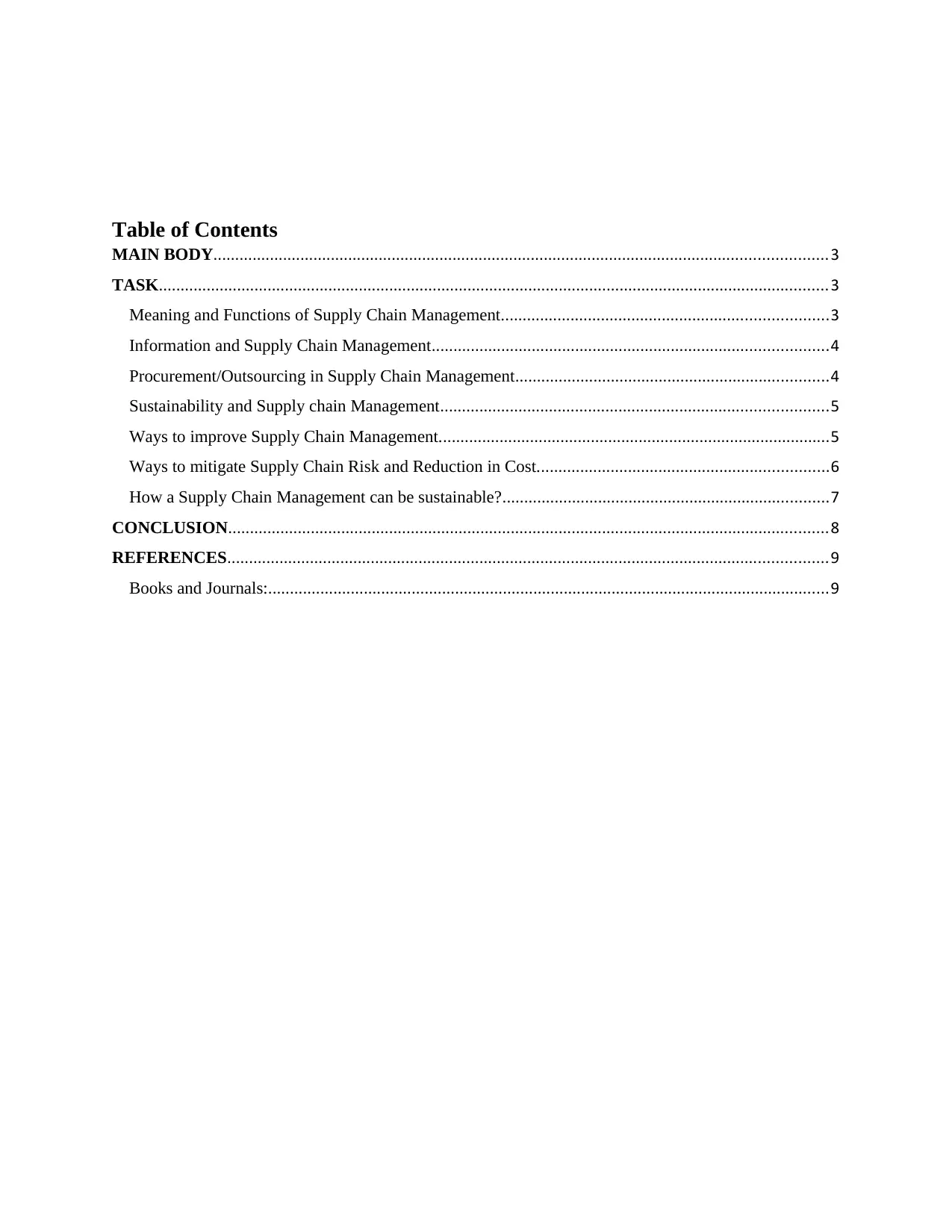
Table of Contents
MAIN BODY.............................................................................................................................................3
TASK..........................................................................................................................................................3
Meaning and Functions of Supply Chain Management...........................................................................3
Information and Supply Chain Management...........................................................................................4
Procurement/Outsourcing in Supply Chain Management........................................................................4
Sustainability and Supply chain Management.........................................................................................5
Ways to improve Supply Chain Management..........................................................................................5
Ways to mitigate Supply Chain Risk and Reduction in Cost...................................................................6
How a Supply Chain Management can be sustainable?...........................................................................7
CONCLUSION..........................................................................................................................................8
REFERENCES..........................................................................................................................................9
Books and Journals:.................................................................................................................................9
MAIN BODY.............................................................................................................................................3
TASK..........................................................................................................................................................3
Meaning and Functions of Supply Chain Management...........................................................................3
Information and Supply Chain Management...........................................................................................4
Procurement/Outsourcing in Supply Chain Management........................................................................4
Sustainability and Supply chain Management.........................................................................................5
Ways to improve Supply Chain Management..........................................................................................5
Ways to mitigate Supply Chain Risk and Reduction in Cost...................................................................6
How a Supply Chain Management can be sustainable?...........................................................................7
CONCLUSION..........................................................................................................................................8
REFERENCES..........................................................................................................................................9
Books and Journals:.................................................................................................................................9
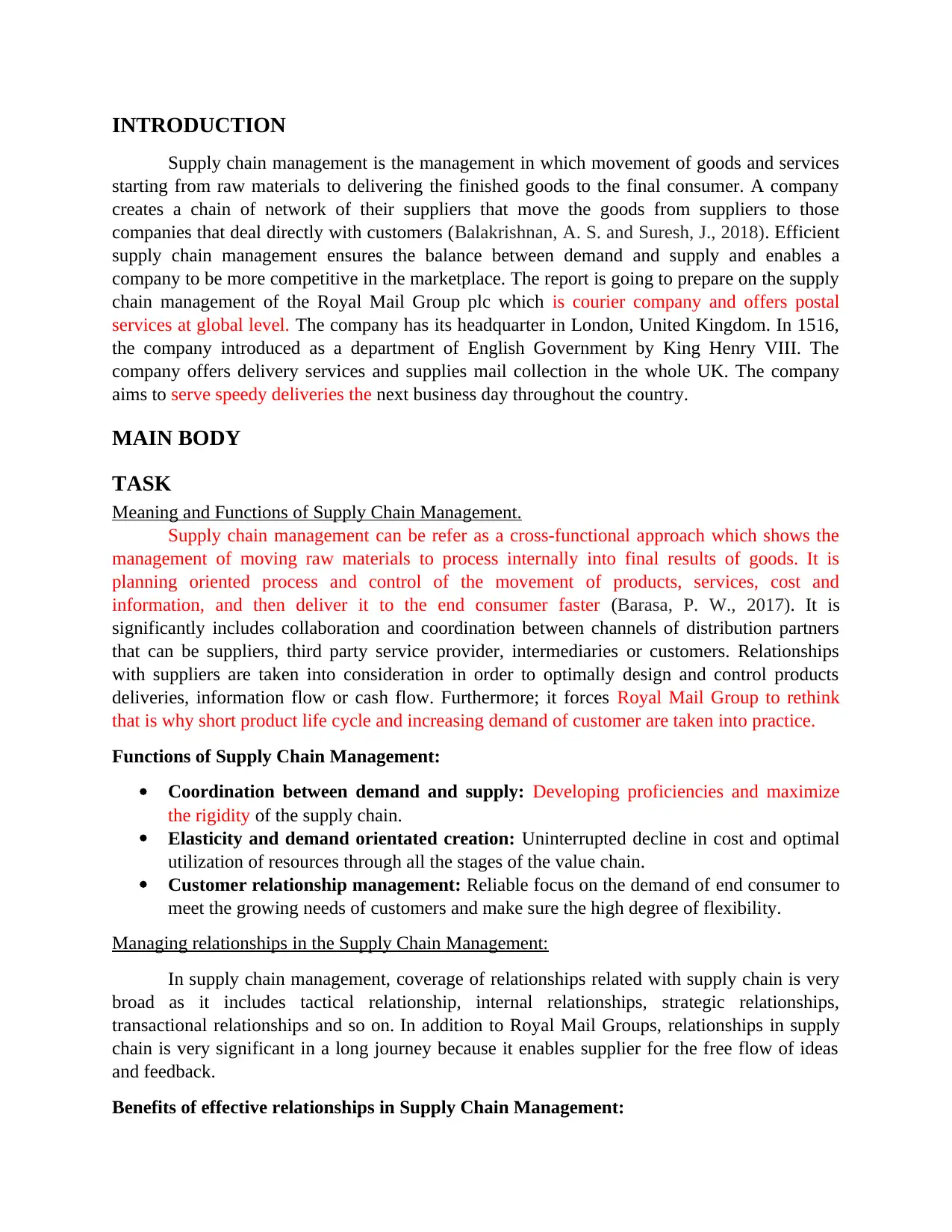
INTRODUCTION
Supply chain management is the management in which movement of goods and services
starting from raw materials to delivering the finished goods to the final consumer. A company
creates a chain of network of their suppliers that move the goods from suppliers to those
companies that deal directly with customers (Balakrishnan, A. S. and Suresh, J., 2018). Efficient
supply chain management ensures the balance between demand and supply and enables a
company to be more competitive in the marketplace. The report is going to prepare on the supply
chain management of the Royal Mail Group plc which is courier company and offers postal
services at global level. The company has its headquarter in London, United Kingdom. In 1516,
the company introduced as a department of English Government by King Henry VIII. The
company offers delivery services and supplies mail collection in the whole UK. The company
aims to serve speedy deliveries the next business day throughout the country.
MAIN BODY
TASK
Meaning and Functions of Supply Chain Management.
Supply chain management can be refer as a cross-functional approach which shows the
management of moving raw materials to process internally into final results of goods. It is
planning oriented process and control of the movement of products, services, cost and
information, and then deliver it to the end consumer faster (Barasa, P. W., 2017). It is
significantly includes collaboration and coordination between channels of distribution partners
that can be suppliers, third party service provider, intermediaries or customers. Relationships
with suppliers are taken into consideration in order to optimally design and control products
deliveries, information flow or cash flow. Furthermore; it forces Royal Mail Group to rethink
that is why short product life cycle and increasing demand of customer are taken into practice.
Functions of Supply Chain Management:
Coordination between demand and supply: Developing proficiencies and maximize
the rigidity of the supply chain.
Elasticity and demand orientated creation: Uninterrupted decline in cost and optimal
utilization of resources through all the stages of the value chain.
Customer relationship management: Reliable focus on the demand of end consumer to
meet the growing needs of customers and make sure the high degree of flexibility.
Managing relationships in the Supply Chain Management:
In supply chain management, coverage of relationships related with supply chain is very
broad as it includes tactical relationship, internal relationships, strategic relationships,
transactional relationships and so on. In addition to Royal Mail Groups, relationships in supply
chain is very significant in a long journey because it enables supplier for the free flow of ideas
and feedback.
Benefits of effective relationships in Supply Chain Management:
Supply chain management is the management in which movement of goods and services
starting from raw materials to delivering the finished goods to the final consumer. A company
creates a chain of network of their suppliers that move the goods from suppliers to those
companies that deal directly with customers (Balakrishnan, A. S. and Suresh, J., 2018). Efficient
supply chain management ensures the balance between demand and supply and enables a
company to be more competitive in the marketplace. The report is going to prepare on the supply
chain management of the Royal Mail Group plc which is courier company and offers postal
services at global level. The company has its headquarter in London, United Kingdom. In 1516,
the company introduced as a department of English Government by King Henry VIII. The
company offers delivery services and supplies mail collection in the whole UK. The company
aims to serve speedy deliveries the next business day throughout the country.
MAIN BODY
TASK
Meaning and Functions of Supply Chain Management.
Supply chain management can be refer as a cross-functional approach which shows the
management of moving raw materials to process internally into final results of goods. It is
planning oriented process and control of the movement of products, services, cost and
information, and then deliver it to the end consumer faster (Barasa, P. W., 2017). It is
significantly includes collaboration and coordination between channels of distribution partners
that can be suppliers, third party service provider, intermediaries or customers. Relationships
with suppliers are taken into consideration in order to optimally design and control products
deliveries, information flow or cash flow. Furthermore; it forces Royal Mail Group to rethink
that is why short product life cycle and increasing demand of customer are taken into practice.
Functions of Supply Chain Management:
Coordination between demand and supply: Developing proficiencies and maximize
the rigidity of the supply chain.
Elasticity and demand orientated creation: Uninterrupted decline in cost and optimal
utilization of resources through all the stages of the value chain.
Customer relationship management: Reliable focus on the demand of end consumer to
meet the growing needs of customers and make sure the high degree of flexibility.
Managing relationships in the Supply Chain Management:
In supply chain management, coverage of relationships related with supply chain is very
broad as it includes tactical relationship, internal relationships, strategic relationships,
transactional relationships and so on. In addition to Royal Mail Groups, relationships in supply
chain is very significant in a long journey because it enables supplier for the free flow of ideas
and feedback.
Benefits of effective relationships in Supply Chain Management:
⊘ This is a preview!⊘
Do you want full access?
Subscribe today to unlock all pages.

Trusted by 1+ million students worldwide
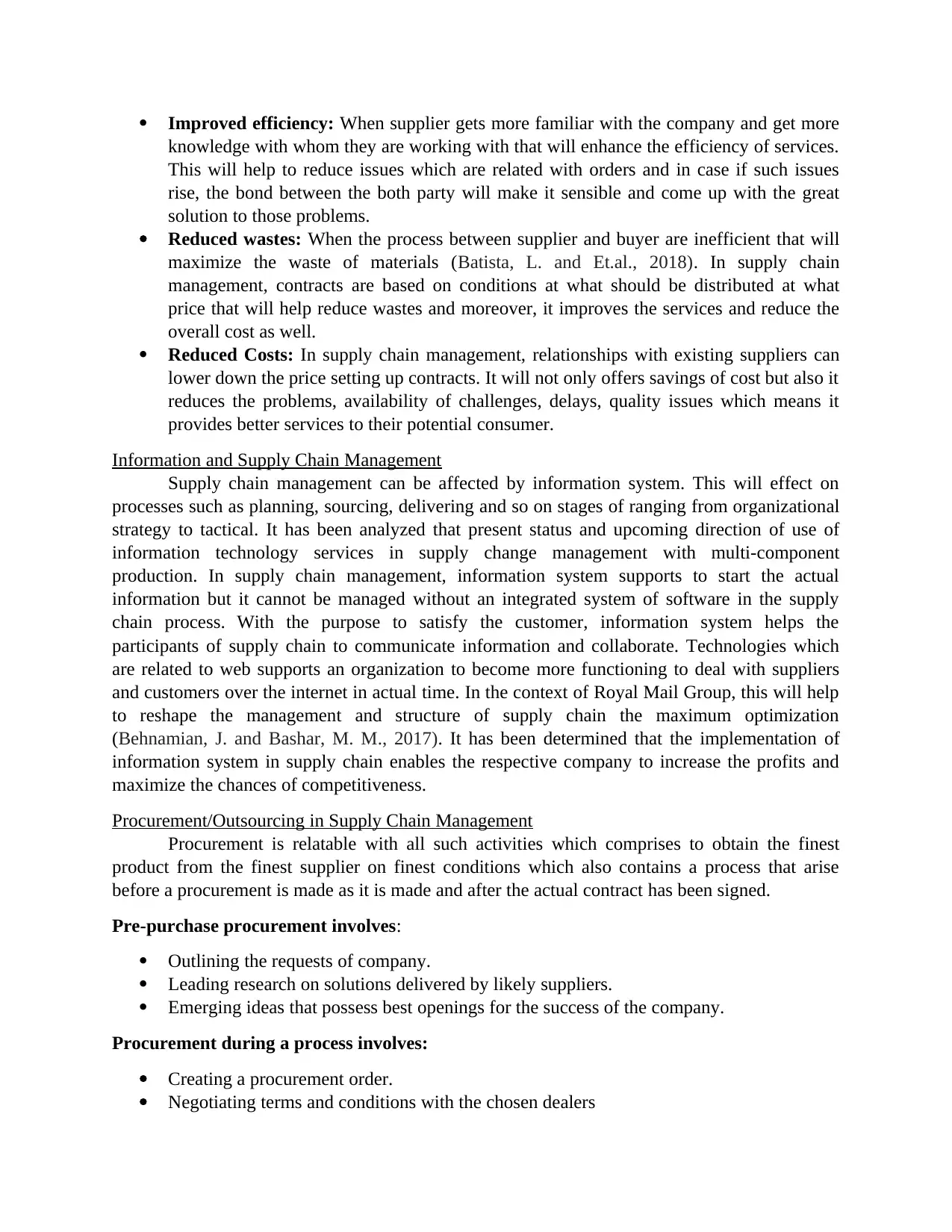
Improved efficiency: When supplier gets more familiar with the company and get more
knowledge with whom they are working with that will enhance the efficiency of services.
This will help to reduce issues which are related with orders and in case if such issues
rise, the bond between the both party will make it sensible and come up with the great
solution to those problems.
Reduced wastes: When the process between supplier and buyer are inefficient that will
maximize the waste of materials (Batista, L. and Et.al., 2018). In supply chain
management, contracts are based on conditions at what should be distributed at what
price that will help reduce wastes and moreover, it improves the services and reduce the
overall cost as well.
Reduced Costs: In supply chain management, relationships with existing suppliers can
lower down the price setting up contracts. It will not only offers savings of cost but also it
reduces the problems, availability of challenges, delays, quality issues which means it
provides better services to their potential consumer.
Information and Supply Chain Management
Supply chain management can be affected by information system. This will effect on
processes such as planning, sourcing, delivering and so on stages of ranging from organizational
strategy to tactical. It has been analyzed that present status and upcoming direction of use of
information technology services in supply change management with multi-component
production. In supply chain management, information system supports to start the actual
information but it cannot be managed without an integrated system of software in the supply
chain process. With the purpose to satisfy the customer, information system helps the
participants of supply chain to communicate information and collaborate. Technologies which
are related to web supports an organization to become more functioning to deal with suppliers
and customers over the internet in actual time. In the context of Royal Mail Group, this will help
to reshape the management and structure of supply chain the maximum optimization
(Behnamian, J. and Bashar, M. M., 2017). It has been determined that the implementation of
information system in supply chain enables the respective company to increase the profits and
maximize the chances of competitiveness.
Procurement/Outsourcing in Supply Chain Management
Procurement is relatable with all such activities which comprises to obtain the finest
product from the finest supplier on finest conditions which also contains a process that arise
before a procurement is made as it is made and after the actual contract has been signed.
Pre-purchase procurement involves:
Outlining the requests of company.
Leading research on solutions delivered by likely suppliers.
Emerging ideas that possess best openings for the success of the company.
Procurement during a process involves:
Creating a procurement order.
Negotiating terms and conditions with the chosen dealers
knowledge with whom they are working with that will enhance the efficiency of services.
This will help to reduce issues which are related with orders and in case if such issues
rise, the bond between the both party will make it sensible and come up with the great
solution to those problems.
Reduced wastes: When the process between supplier and buyer are inefficient that will
maximize the waste of materials (Batista, L. and Et.al., 2018). In supply chain
management, contracts are based on conditions at what should be distributed at what
price that will help reduce wastes and moreover, it improves the services and reduce the
overall cost as well.
Reduced Costs: In supply chain management, relationships with existing suppliers can
lower down the price setting up contracts. It will not only offers savings of cost but also it
reduces the problems, availability of challenges, delays, quality issues which means it
provides better services to their potential consumer.
Information and Supply Chain Management
Supply chain management can be affected by information system. This will effect on
processes such as planning, sourcing, delivering and so on stages of ranging from organizational
strategy to tactical. It has been analyzed that present status and upcoming direction of use of
information technology services in supply change management with multi-component
production. In supply chain management, information system supports to start the actual
information but it cannot be managed without an integrated system of software in the supply
chain process. With the purpose to satisfy the customer, information system helps the
participants of supply chain to communicate information and collaborate. Technologies which
are related to web supports an organization to become more functioning to deal with suppliers
and customers over the internet in actual time. In the context of Royal Mail Group, this will help
to reshape the management and structure of supply chain the maximum optimization
(Behnamian, J. and Bashar, M. M., 2017). It has been determined that the implementation of
information system in supply chain enables the respective company to increase the profits and
maximize the chances of competitiveness.
Procurement/Outsourcing in Supply Chain Management
Procurement is relatable with all such activities which comprises to obtain the finest
product from the finest supplier on finest conditions which also contains a process that arise
before a procurement is made as it is made and after the actual contract has been signed.
Pre-purchase procurement involves:
Outlining the requests of company.
Leading research on solutions delivered by likely suppliers.
Emerging ideas that possess best openings for the success of the company.
Procurement during a process involves:
Creating a procurement order.
Negotiating terms and conditions with the chosen dealers
Paraphrase This Document
Need a fresh take? Get an instant paraphrase of this document with our AI Paraphraser
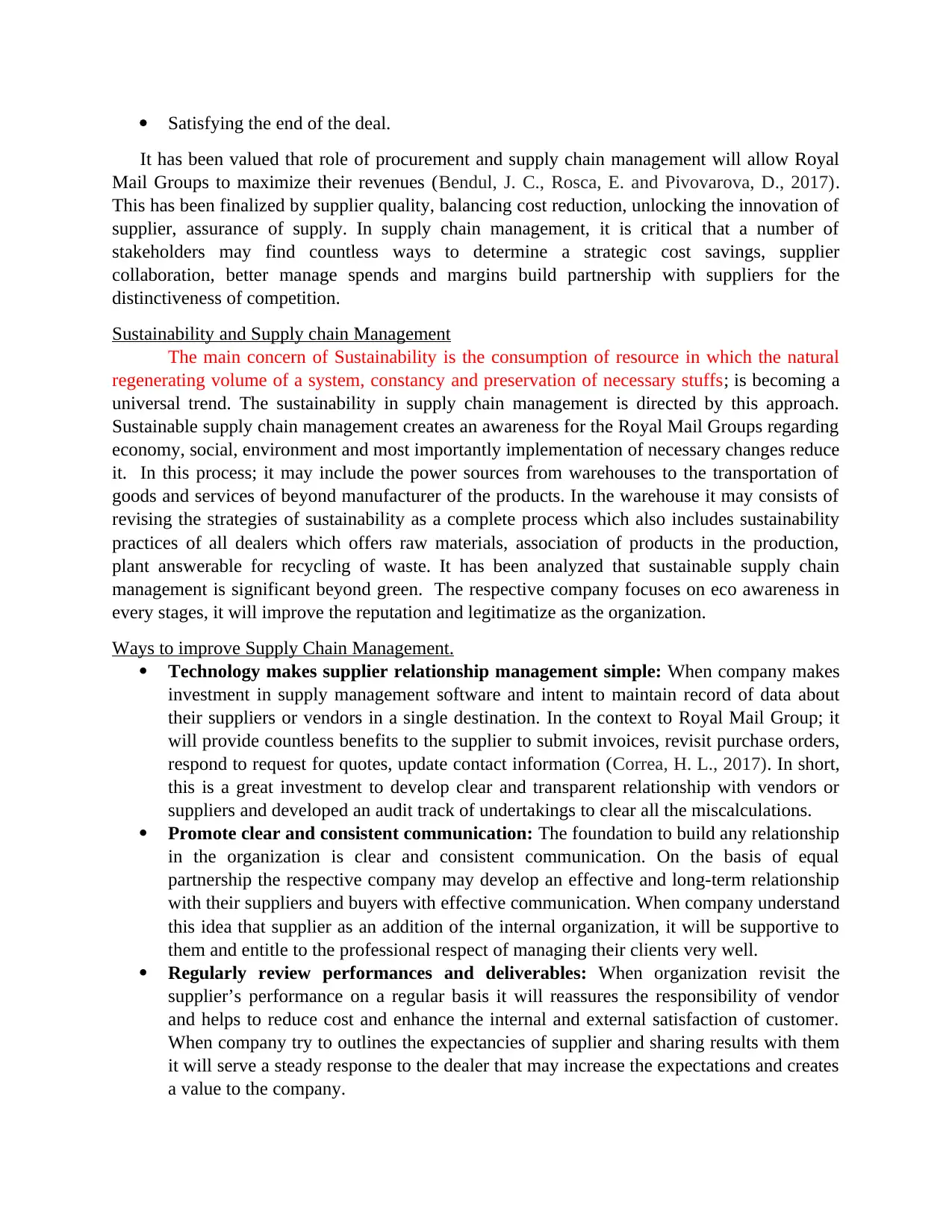
Satisfying the end of the deal.
It has been valued that role of procurement and supply chain management will allow Royal
Mail Groups to maximize their revenues (Bendul, J. C., Rosca, E. and Pivovarova, D., 2017).
This has been finalized by supplier quality, balancing cost reduction, unlocking the innovation of
supplier, assurance of supply. In supply chain management, it is critical that a number of
stakeholders may find countless ways to determine a strategic cost savings, supplier
collaboration, better manage spends and margins build partnership with suppliers for the
distinctiveness of competition.
Sustainability and Supply chain Management
The main concern of Sustainability is the consumption of resource in which the natural
regenerating volume of a system, constancy and preservation of necessary stuffs; is becoming a
universal trend. The sustainability in supply chain management is directed by this approach.
Sustainable supply chain management creates an awareness for the Royal Mail Groups regarding
economy, social, environment and most importantly implementation of necessary changes reduce
it. In this process; it may include the power sources from warehouses to the transportation of
goods and services of beyond manufacturer of the products. In the warehouse it may consists of
revising the strategies of sustainability as a complete process which also includes sustainability
practices of all dealers which offers raw materials, association of products in the production,
plant answerable for recycling of waste. It has been analyzed that sustainable supply chain
management is significant beyond green. The respective company focuses on eco awareness in
every stages, it will improve the reputation and legitimatize as the organization.
Ways to improve Supply Chain Management.
Technology makes supplier relationship management simple: When company makes
investment in supply management software and intent to maintain record of data about
their suppliers or vendors in a single destination. In the context to Royal Mail Group; it
will provide countless benefits to the supplier to submit invoices, revisit purchase orders,
respond to request for quotes, update contact information (Correa, H. L., 2017). In short,
this is a great investment to develop clear and transparent relationship with vendors or
suppliers and developed an audit track of undertakings to clear all the miscalculations.
Promote clear and consistent communication: The foundation to build any relationship
in the organization is clear and consistent communication. On the basis of equal
partnership the respective company may develop an effective and long-term relationship
with their suppliers and buyers with effective communication. When company understand
this idea that supplier as an addition of the internal organization, it will be supportive to
them and entitle to the professional respect of managing their clients very well.
Regularly review performances and deliverables: When organization revisit the
supplier’s performance on a regular basis it will reassures the responsibility of vendor
and helps to reduce cost and enhance the internal and external satisfaction of customer.
When company try to outlines the expectancies of supplier and sharing results with them
it will serve a steady response to the dealer that may increase the expectations and creates
a value to the company.
It has been valued that role of procurement and supply chain management will allow Royal
Mail Groups to maximize their revenues (Bendul, J. C., Rosca, E. and Pivovarova, D., 2017).
This has been finalized by supplier quality, balancing cost reduction, unlocking the innovation of
supplier, assurance of supply. In supply chain management, it is critical that a number of
stakeholders may find countless ways to determine a strategic cost savings, supplier
collaboration, better manage spends and margins build partnership with suppliers for the
distinctiveness of competition.
Sustainability and Supply chain Management
The main concern of Sustainability is the consumption of resource in which the natural
regenerating volume of a system, constancy and preservation of necessary stuffs; is becoming a
universal trend. The sustainability in supply chain management is directed by this approach.
Sustainable supply chain management creates an awareness for the Royal Mail Groups regarding
economy, social, environment and most importantly implementation of necessary changes reduce
it. In this process; it may include the power sources from warehouses to the transportation of
goods and services of beyond manufacturer of the products. In the warehouse it may consists of
revising the strategies of sustainability as a complete process which also includes sustainability
practices of all dealers which offers raw materials, association of products in the production,
plant answerable for recycling of waste. It has been analyzed that sustainable supply chain
management is significant beyond green. The respective company focuses on eco awareness in
every stages, it will improve the reputation and legitimatize as the organization.
Ways to improve Supply Chain Management.
Technology makes supplier relationship management simple: When company makes
investment in supply management software and intent to maintain record of data about
their suppliers or vendors in a single destination. In the context to Royal Mail Group; it
will provide countless benefits to the supplier to submit invoices, revisit purchase orders,
respond to request for quotes, update contact information (Correa, H. L., 2017). In short,
this is a great investment to develop clear and transparent relationship with vendors or
suppliers and developed an audit track of undertakings to clear all the miscalculations.
Promote clear and consistent communication: The foundation to build any relationship
in the organization is clear and consistent communication. On the basis of equal
partnership the respective company may develop an effective and long-term relationship
with their suppliers and buyers with effective communication. When company understand
this idea that supplier as an addition of the internal organization, it will be supportive to
them and entitle to the professional respect of managing their clients very well.
Regularly review performances and deliverables: When organization revisit the
supplier’s performance on a regular basis it will reassures the responsibility of vendor
and helps to reduce cost and enhance the internal and external satisfaction of customer.
When company try to outlines the expectancies of supplier and sharing results with them
it will serve a steady response to the dealer that may increase the expectations and creates
a value to the company.
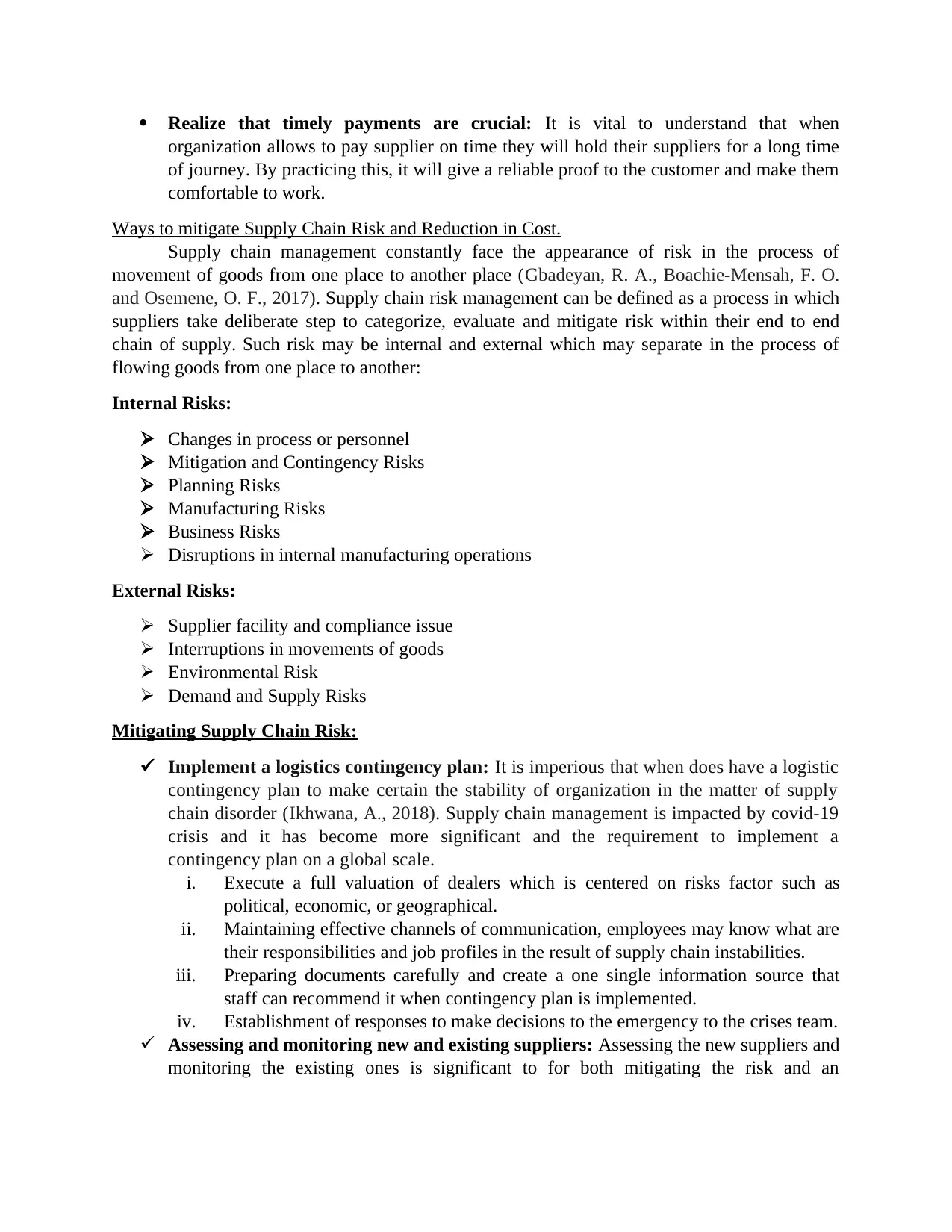
Realize that timely payments are crucial: It is vital to understand that when
organization allows to pay supplier on time they will hold their suppliers for a long time
of journey. By practicing this, it will give a reliable proof to the customer and make them
comfortable to work.
Ways to mitigate Supply Chain Risk and Reduction in Cost.
Supply chain management constantly face the appearance of risk in the process of
movement of goods from one place to another place (Gbadeyan, R. A., Boachie-Mensah, F. O.
and Osemene, O. F., 2017). Supply chain risk management can be defined as a process in which
suppliers take deliberate step to categorize, evaluate and mitigate risk within their end to end
chain of supply. Such risk may be internal and external which may separate in the process of
flowing goods from one place to another:
Internal Risks:
Changes in process or personnel
Mitigation and Contingency Risks
Planning Risks
Manufacturing Risks
Business Risks
Disruptions in internal manufacturing operations
External Risks:
Supplier facility and compliance issue
Interruptions in movements of goods
Environmental Risk
Demand and Supply Risks
Mitigating Supply Chain Risk:
Implement a logistics contingency plan: It is imperious that when does have a logistic
contingency plan to make certain the stability of organization in the matter of supply
chain disorder (Ikhwana, A., 2018). Supply chain management is impacted by covid-19
crisis and it has become more significant and the requirement to implement a
contingency plan on a global scale.
i. Execute a full valuation of dealers which is centered on risks factor such as
political, economic, or geographical.
ii. Maintaining effective channels of communication, employees may know what are
their responsibilities and job profiles in the result of supply chain instabilities.
iii. Preparing documents carefully and create a one single information source that
staff can recommend it when contingency plan is implemented.
iv. Establishment of responses to make decisions to the emergency to the crises team.
Assessing and monitoring new and existing suppliers: Assessing the new suppliers and
monitoring the existing ones is significant to for both mitigating the risk and an
organization allows to pay supplier on time they will hold their suppliers for a long time
of journey. By practicing this, it will give a reliable proof to the customer and make them
comfortable to work.
Ways to mitigate Supply Chain Risk and Reduction in Cost.
Supply chain management constantly face the appearance of risk in the process of
movement of goods from one place to another place (Gbadeyan, R. A., Boachie-Mensah, F. O.
and Osemene, O. F., 2017). Supply chain risk management can be defined as a process in which
suppliers take deliberate step to categorize, evaluate and mitigate risk within their end to end
chain of supply. Such risk may be internal and external which may separate in the process of
flowing goods from one place to another:
Internal Risks:
Changes in process or personnel
Mitigation and Contingency Risks
Planning Risks
Manufacturing Risks
Business Risks
Disruptions in internal manufacturing operations
External Risks:
Supplier facility and compliance issue
Interruptions in movements of goods
Environmental Risk
Demand and Supply Risks
Mitigating Supply Chain Risk:
Implement a logistics contingency plan: It is imperious that when does have a logistic
contingency plan to make certain the stability of organization in the matter of supply
chain disorder (Ikhwana, A., 2018). Supply chain management is impacted by covid-19
crisis and it has become more significant and the requirement to implement a
contingency plan on a global scale.
i. Execute a full valuation of dealers which is centered on risks factor such as
political, economic, or geographical.
ii. Maintaining effective channels of communication, employees may know what are
their responsibilities and job profiles in the result of supply chain instabilities.
iii. Preparing documents carefully and create a one single information source that
staff can recommend it when contingency plan is implemented.
iv. Establishment of responses to make decisions to the emergency to the crises team.
Assessing and monitoring new and existing suppliers: Assessing the new suppliers and
monitoring the existing ones is significant to for both mitigating the risk and an
⊘ This is a preview!⊘
Do you want full access?
Subscribe today to unlock all pages.

Trusted by 1+ million students worldwide
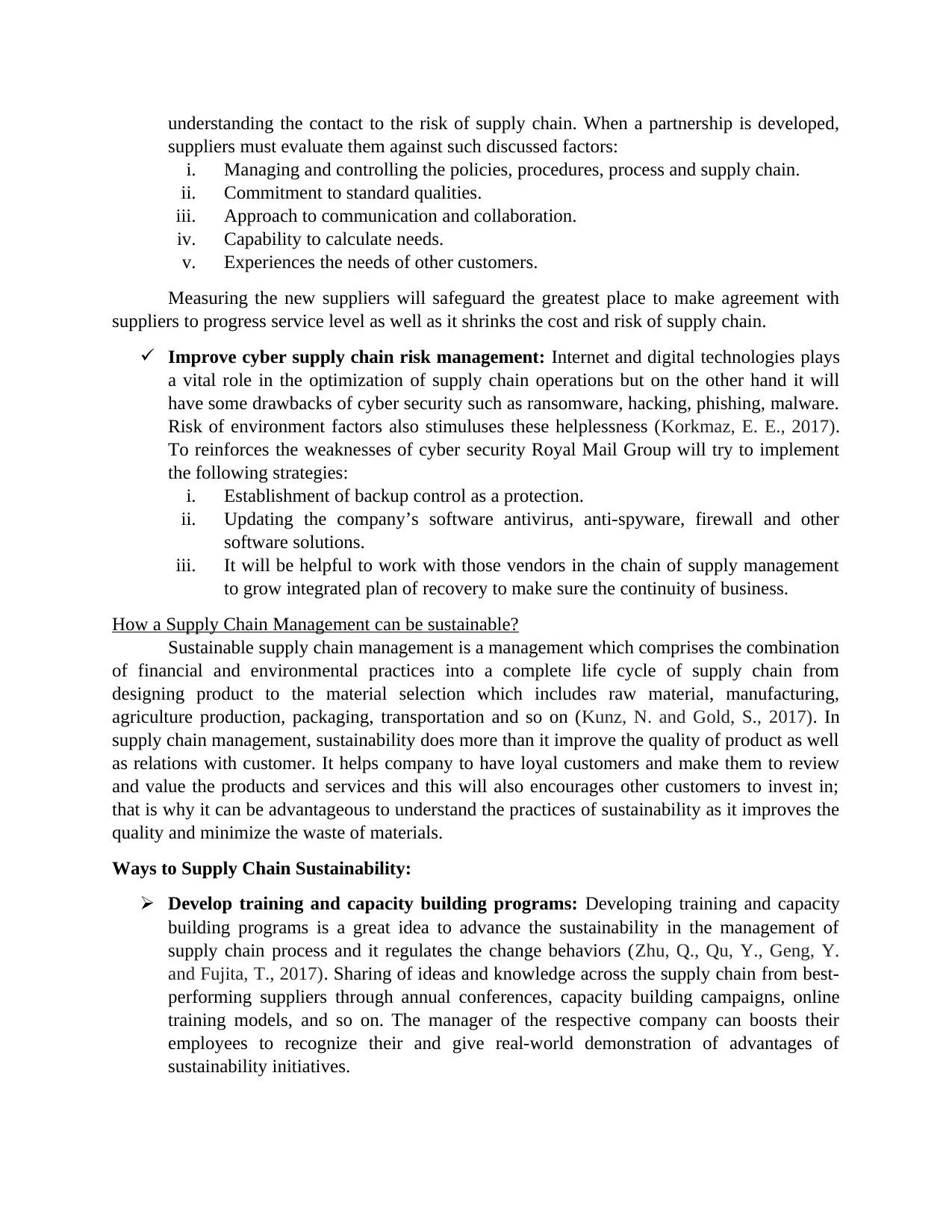
understanding the contact to the risk of supply chain. When a partnership is developed,
suppliers must evaluate them against such discussed factors:
i. Managing and controlling the policies, procedures, process and supply chain.
ii. Commitment to standard qualities.
iii. Approach to communication and collaboration.
iv. Capability to calculate needs.
v. Experiences the needs of other customers.
Measuring the new suppliers will safeguard the greatest place to make agreement with
suppliers to progress service level as well as it shrinks the cost and risk of supply chain.
Improve cyber supply chain risk management: Internet and digital technologies plays
a vital role in the optimization of supply chain operations but on the other hand it will
have some drawbacks of cyber security such as ransomware, hacking, phishing, malware.
Risk of environment factors also stimuluses these helplessness (Korkmaz, E. E., 2017).
To reinforces the weaknesses of cyber security Royal Mail Group will try to implement
the following strategies:
i. Establishment of backup control as a protection.
ii. Updating the company’s software antivirus, anti-spyware, firewall and other
software solutions.
iii. It will be helpful to work with those vendors in the chain of supply management
to grow integrated plan of recovery to make sure the continuity of business.
How a Supply Chain Management can be sustainable?
Sustainable supply chain management is a management which comprises the combination
of financial and environmental practices into a complete life cycle of supply chain from
designing product to the material selection which includes raw material, manufacturing,
agriculture production, packaging, transportation and so on (Kunz, N. and Gold, S., 2017). In
supply chain management, sustainability does more than it improve the quality of product as well
as relations with customer. It helps company to have loyal customers and make them to review
and value the products and services and this will also encourages other customers to invest in;
that is why it can be advantageous to understand the practices of sustainability as it improves the
quality and minimize the waste of materials.
Ways to Supply Chain Sustainability:
Develop training and capacity building programs: Developing training and capacity
building programs is a great idea to advance the sustainability in the management of
supply chain process and it regulates the change behaviors (Zhu, Q., Qu, Y., Geng, Y.
and Fujita, T., 2017). Sharing of ideas and knowledge across the supply chain from best-
performing suppliers through annual conferences, capacity building campaigns, online
training models, and so on. The manager of the respective company can boosts their
employees to recognize their and give real-world demonstration of advantages of
sustainability initiatives.
suppliers must evaluate them against such discussed factors:
i. Managing and controlling the policies, procedures, process and supply chain.
ii. Commitment to standard qualities.
iii. Approach to communication and collaboration.
iv. Capability to calculate needs.
v. Experiences the needs of other customers.
Measuring the new suppliers will safeguard the greatest place to make agreement with
suppliers to progress service level as well as it shrinks the cost and risk of supply chain.
Improve cyber supply chain risk management: Internet and digital technologies plays
a vital role in the optimization of supply chain operations but on the other hand it will
have some drawbacks of cyber security such as ransomware, hacking, phishing, malware.
Risk of environment factors also stimuluses these helplessness (Korkmaz, E. E., 2017).
To reinforces the weaknesses of cyber security Royal Mail Group will try to implement
the following strategies:
i. Establishment of backup control as a protection.
ii. Updating the company’s software antivirus, anti-spyware, firewall and other
software solutions.
iii. It will be helpful to work with those vendors in the chain of supply management
to grow integrated plan of recovery to make sure the continuity of business.
How a Supply Chain Management can be sustainable?
Sustainable supply chain management is a management which comprises the combination
of financial and environmental practices into a complete life cycle of supply chain from
designing product to the material selection which includes raw material, manufacturing,
agriculture production, packaging, transportation and so on (Kunz, N. and Gold, S., 2017). In
supply chain management, sustainability does more than it improve the quality of product as well
as relations with customer. It helps company to have loyal customers and make them to review
and value the products and services and this will also encourages other customers to invest in;
that is why it can be advantageous to understand the practices of sustainability as it improves the
quality and minimize the waste of materials.
Ways to Supply Chain Sustainability:
Develop training and capacity building programs: Developing training and capacity
building programs is a great idea to advance the sustainability in the management of
supply chain process and it regulates the change behaviors (Zhu, Q., Qu, Y., Geng, Y.
and Fujita, T., 2017). Sharing of ideas and knowledge across the supply chain from best-
performing suppliers through annual conferences, capacity building campaigns, online
training models, and so on. The manager of the respective company can boosts their
employees to recognize their and give real-world demonstration of advantages of
sustainability initiatives.
Paraphrase This Document
Need a fresh take? Get an instant paraphrase of this document with our AI Paraphraser
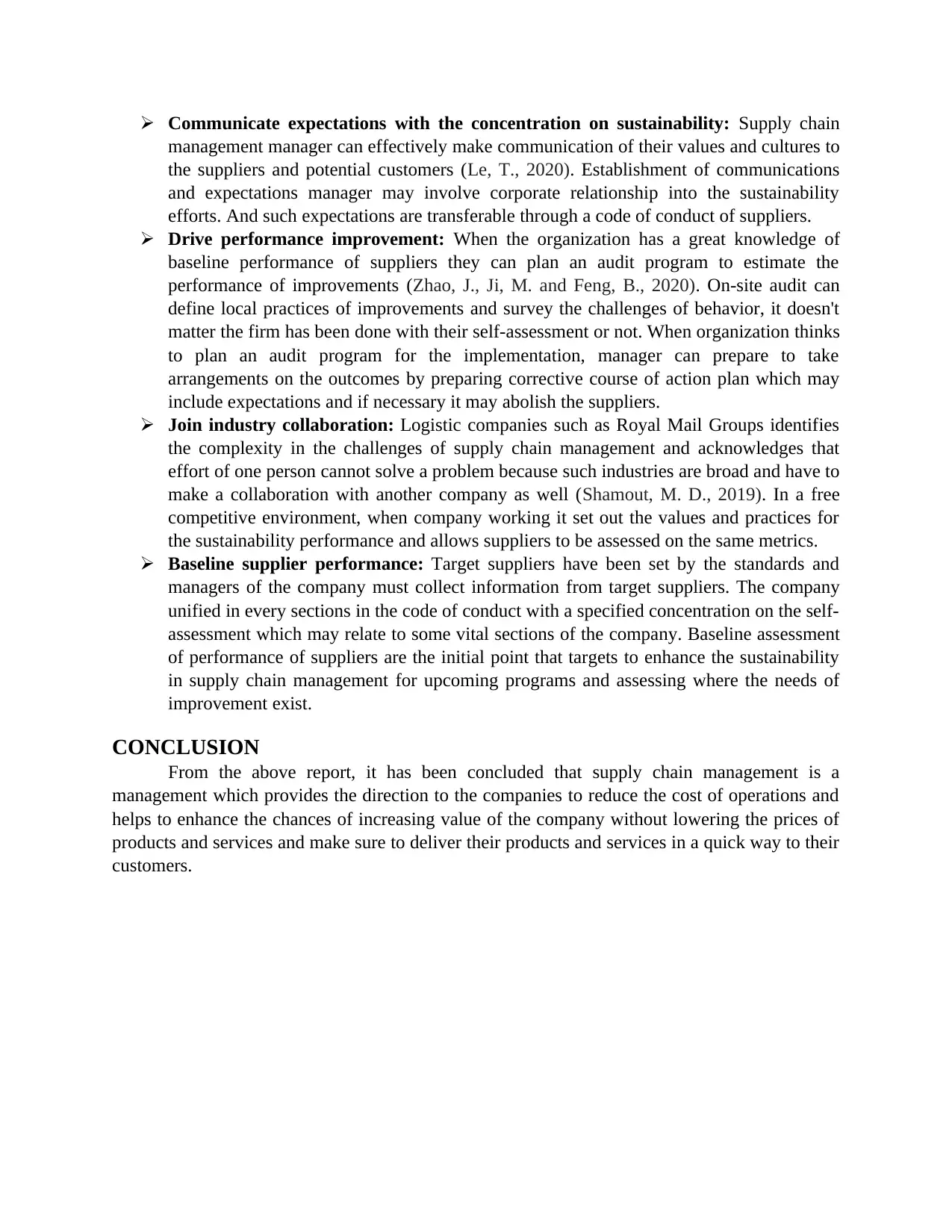
Communicate expectations with the concentration on sustainability: Supply chain
management manager can effectively make communication of their values and cultures to
the suppliers and potential customers (Le, T., 2020). Establishment of communications
and expectations manager may involve corporate relationship into the sustainability
efforts. And such expectations are transferable through a code of conduct of suppliers.
Drive performance improvement: When the organization has a great knowledge of
baseline performance of suppliers they can plan an audit program to estimate the
performance of improvements (Zhao, J., Ji, M. and Feng, B., 2020). On-site audit can
define local practices of improvements and survey the challenges of behavior, it doesn't
matter the firm has been done with their self-assessment or not. When organization thinks
to plan an audit program for the implementation, manager can prepare to take
arrangements on the outcomes by preparing corrective course of action plan which may
include expectations and if necessary it may abolish the suppliers.
Join industry collaboration: Logistic companies such as Royal Mail Groups identifies
the complexity in the challenges of supply chain management and acknowledges that
effort of one person cannot solve a problem because such industries are broad and have to
make a collaboration with another company as well (Shamout, M. D., 2019). In a free
competitive environment, when company working it set out the values and practices for
the sustainability performance and allows suppliers to be assessed on the same metrics.
Baseline supplier performance: Target suppliers have been set by the standards and
managers of the company must collect information from target suppliers. The company
unified in every sections in the code of conduct with a specified concentration on the self-
assessment which may relate to some vital sections of the company. Baseline assessment
of performance of suppliers are the initial point that targets to enhance the sustainability
in supply chain management for upcoming programs and assessing where the needs of
improvement exist.
CONCLUSION
From the above report, it has been concluded that supply chain management is a
management which provides the direction to the companies to reduce the cost of operations and
helps to enhance the chances of increasing value of the company without lowering the prices of
products and services and make sure to deliver their products and services in a quick way to their
customers.
management manager can effectively make communication of their values and cultures to
the suppliers and potential customers (Le, T., 2020). Establishment of communications
and expectations manager may involve corporate relationship into the sustainability
efforts. And such expectations are transferable through a code of conduct of suppliers.
Drive performance improvement: When the organization has a great knowledge of
baseline performance of suppliers they can plan an audit program to estimate the
performance of improvements (Zhao, J., Ji, M. and Feng, B., 2020). On-site audit can
define local practices of improvements and survey the challenges of behavior, it doesn't
matter the firm has been done with their self-assessment or not. When organization thinks
to plan an audit program for the implementation, manager can prepare to take
arrangements on the outcomes by preparing corrective course of action plan which may
include expectations and if necessary it may abolish the suppliers.
Join industry collaboration: Logistic companies such as Royal Mail Groups identifies
the complexity in the challenges of supply chain management and acknowledges that
effort of one person cannot solve a problem because such industries are broad and have to
make a collaboration with another company as well (Shamout, M. D., 2019). In a free
competitive environment, when company working it set out the values and practices for
the sustainability performance and allows suppliers to be assessed on the same metrics.
Baseline supplier performance: Target suppliers have been set by the standards and
managers of the company must collect information from target suppliers. The company
unified in every sections in the code of conduct with a specified concentration on the self-
assessment which may relate to some vital sections of the company. Baseline assessment
of performance of suppliers are the initial point that targets to enhance the sustainability
in supply chain management for upcoming programs and assessing where the needs of
improvement exist.
CONCLUSION
From the above report, it has been concluded that supply chain management is a
management which provides the direction to the companies to reduce the cost of operations and
helps to enhance the chances of increasing value of the company without lowering the prices of
products and services and make sure to deliver their products and services in a quick way to their
customers.
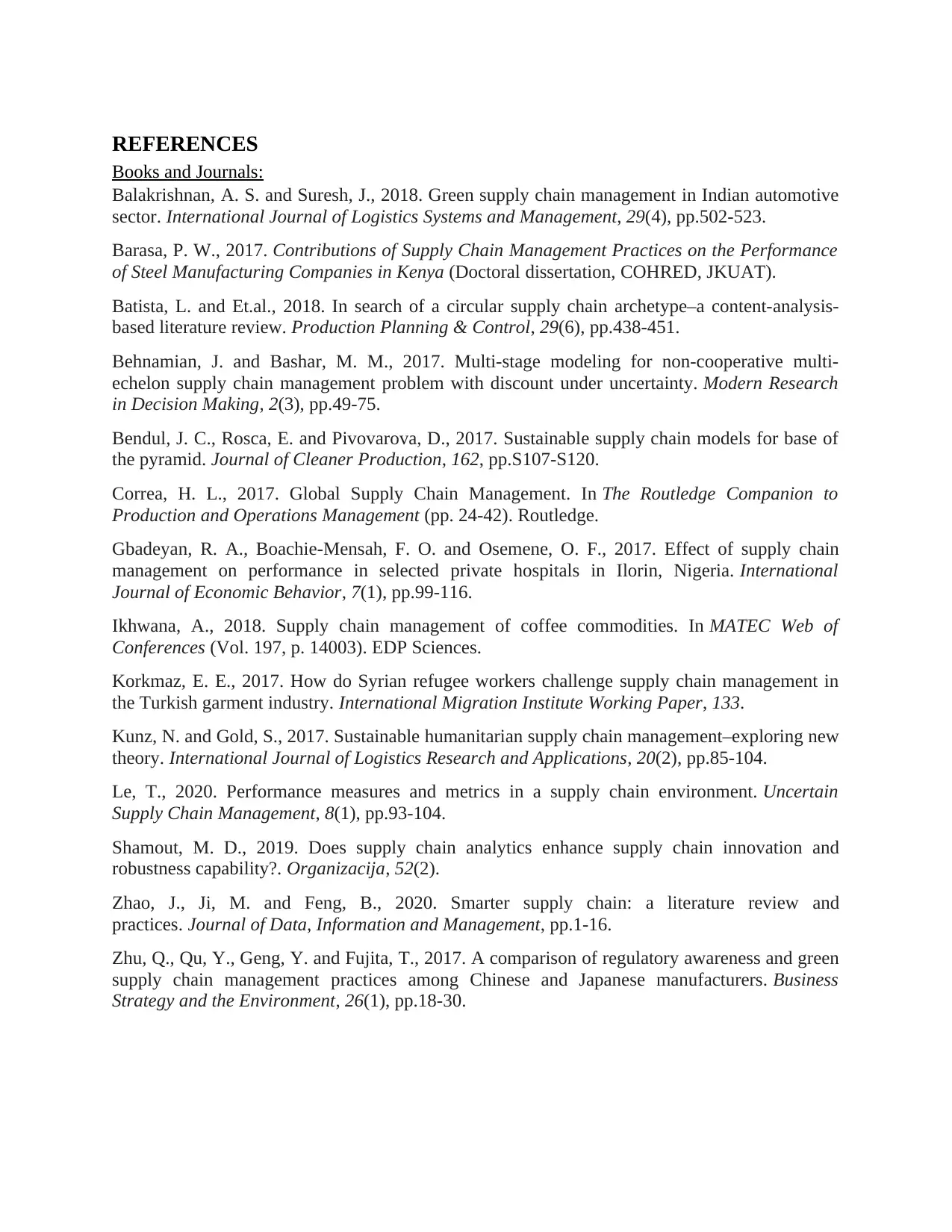
REFERENCES
Books and Journals:
Balakrishnan, A. S. and Suresh, J., 2018. Green supply chain management in Indian automotive
sector. International Journal of Logistics Systems and Management, 29(4), pp.502-523.
Barasa, P. W., 2017. Contributions of Supply Chain Management Practices on the Performance
of Steel Manufacturing Companies in Kenya (Doctoral dissertation, COHRED, JKUAT).
Batista, L. and Et.al., 2018. In search of a circular supply chain archetype–a content-analysis-
based literature review. Production Planning & Control, 29(6), pp.438-451.
Behnamian, J. and Bashar, M. M., 2017. Multi-stage modeling for non-cooperative multi-
echelon supply chain management problem with discount under uncertainty. Modern Research
in Decision Making, 2(3), pp.49-75.
Bendul, J. C., Rosca, E. and Pivovarova, D., 2017. Sustainable supply chain models for base of
the pyramid. Journal of Cleaner Production, 162, pp.S107-S120.
Correa, H. L., 2017. Global Supply Chain Management. In The Routledge Companion to
Production and Operations Management (pp. 24-42). Routledge.
Gbadeyan, R. A., Boachie-Mensah, F. O. and Osemene, O. F., 2017. Effect of supply chain
management on performance in selected private hospitals in Ilorin, Nigeria. International
Journal of Economic Behavior, 7(1), pp.99-116.
Ikhwana, A., 2018. Supply chain management of coffee commodities. In MATEC Web of
Conferences (Vol. 197, p. 14003). EDP Sciences.
Korkmaz, E. E., 2017. How do Syrian refugee workers challenge supply chain management in
the Turkish garment industry. International Migration Institute Working Paper, 133.
Kunz, N. and Gold, S., 2017. Sustainable humanitarian supply chain management–exploring new
theory. International Journal of Logistics Research and Applications, 20(2), pp.85-104.
Le, T., 2020. Performance measures and metrics in a supply chain environment. Uncertain
Supply Chain Management, 8(1), pp.93-104.
Shamout, M. D., 2019. Does supply chain analytics enhance supply chain innovation and
robustness capability?. Organizacija, 52(2).
Zhao, J., Ji, M. and Feng, B., 2020. Smarter supply chain: a literature review and
practices. Journal of Data, Information and Management, pp.1-16.
Zhu, Q., Qu, Y., Geng, Y. and Fujita, T., 2017. A comparison of regulatory awareness and green
supply chain management practices among Chinese and Japanese manufacturers. Business
Strategy and the Environment, 26(1), pp.18-30.
Books and Journals:
Balakrishnan, A. S. and Suresh, J., 2018. Green supply chain management in Indian automotive
sector. International Journal of Logistics Systems and Management, 29(4), pp.502-523.
Barasa, P. W., 2017. Contributions of Supply Chain Management Practices on the Performance
of Steel Manufacturing Companies in Kenya (Doctoral dissertation, COHRED, JKUAT).
Batista, L. and Et.al., 2018. In search of a circular supply chain archetype–a content-analysis-
based literature review. Production Planning & Control, 29(6), pp.438-451.
Behnamian, J. and Bashar, M. M., 2017. Multi-stage modeling for non-cooperative multi-
echelon supply chain management problem with discount under uncertainty. Modern Research
in Decision Making, 2(3), pp.49-75.
Bendul, J. C., Rosca, E. and Pivovarova, D., 2017. Sustainable supply chain models for base of
the pyramid. Journal of Cleaner Production, 162, pp.S107-S120.
Correa, H. L., 2017. Global Supply Chain Management. In The Routledge Companion to
Production and Operations Management (pp. 24-42). Routledge.
Gbadeyan, R. A., Boachie-Mensah, F. O. and Osemene, O. F., 2017. Effect of supply chain
management on performance in selected private hospitals in Ilorin, Nigeria. International
Journal of Economic Behavior, 7(1), pp.99-116.
Ikhwana, A., 2018. Supply chain management of coffee commodities. In MATEC Web of
Conferences (Vol. 197, p. 14003). EDP Sciences.
Korkmaz, E. E., 2017. How do Syrian refugee workers challenge supply chain management in
the Turkish garment industry. International Migration Institute Working Paper, 133.
Kunz, N. and Gold, S., 2017. Sustainable humanitarian supply chain management–exploring new
theory. International Journal of Logistics Research and Applications, 20(2), pp.85-104.
Le, T., 2020. Performance measures and metrics in a supply chain environment. Uncertain
Supply Chain Management, 8(1), pp.93-104.
Shamout, M. D., 2019. Does supply chain analytics enhance supply chain innovation and
robustness capability?. Organizacija, 52(2).
Zhao, J., Ji, M. and Feng, B., 2020. Smarter supply chain: a literature review and
practices. Journal of Data, Information and Management, pp.1-16.
Zhu, Q., Qu, Y., Geng, Y. and Fujita, T., 2017. A comparison of regulatory awareness and green
supply chain management practices among Chinese and Japanese manufacturers. Business
Strategy and the Environment, 26(1), pp.18-30.
⊘ This is a preview!⊘
Do you want full access?
Subscribe today to unlock all pages.

Trusted by 1+ million students worldwide
1 out of 9
Related Documents
Your All-in-One AI-Powered Toolkit for Academic Success.
+13062052269
info@desklib.com
Available 24*7 on WhatsApp / Email
![[object Object]](/_next/static/media/star-bottom.7253800d.svg)
Unlock your academic potential
Copyright © 2020–2025 A2Z Services. All Rights Reserved. Developed and managed by ZUCOL.





